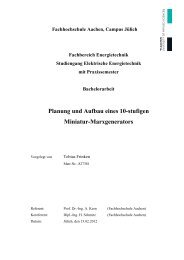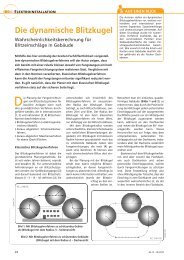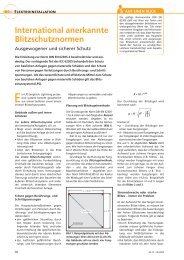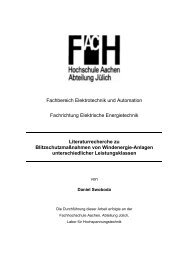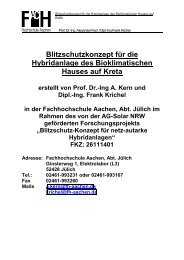Simulation of electric and magnetic fields using FEMM - FH Aachen ...
Simulation of electric and magnetic fields using FEMM - FH Aachen ...
Simulation of electric and magnetic fields using FEMM - FH Aachen ...
Create successful ePaper yourself
Turn your PDF publications into a flip-book with our unique Google optimized e-Paper software.
0. Introduction<br />
Finite Element Method Magnetics (<strong>FEMM</strong>) is a finite element package for solving<br />
2-dimensional planar <strong>and</strong> axisymmetric problems in electrostatics, current flow, heat flow<br />
<strong>and</strong> in low frequency <strong>magnetic</strong>s. It is a very convenient program.<br />
<strong>FEMM</strong> is divided into three parts:<br />
• Interactive shell (femm.exe). This program is a Multiple Document Interface<br />
pre-processor <strong>and</strong> a post-processor for the various types <strong>of</strong> problems solved by <strong>FEMM</strong>. It<br />
contains a CAD like interface for laying out the geometry <strong>of</strong> the problem to be solved <strong>and</strong><br />
for defining material properties <strong>and</strong> boundary conditions. Autocad DXF files can be<br />
imported to facilitate the analysis <strong>of</strong> existing geometries. Field solutions can be displayed<br />
in the form <strong>of</strong> contour <strong>and</strong> density plots. The program also allows the user to inspect the<br />
field at arbitrary points, as well as evaluate a number <strong>of</strong> different integrals <strong>and</strong> plot various<br />
quantities <strong>of</strong> interest along user-defined contours.<br />
•Triangle.exe. Triangle breaks down the solution region into a large number <strong>of</strong> triangles, a<br />
vital part <strong>of</strong> the finite element process. This program was written by Jonathan Shewchuk<br />
<strong>and</strong> is available from his Carnegie-Mellon University web page at<br />
http://www.cs.cmu.edu/˜quake/triangle.html or from Netlib.<br />
• Solvers (fkern.exe for <strong>magnetic</strong>s; belasolv for electrostatics); hsolv for heat flow<br />
problems; <strong>and</strong> csolv for current flow problems. Each solver takes a set <strong>of</strong> data files that<br />
describe problem <strong>and</strong> solves the relevant partial differential equations to obtain values for<br />
the desired field throughout the solution domain. 1<br />
What I have done in my thesis is showing you how to analyze model <strong>using</strong> <strong>FEMM</strong> 4.2.<br />
Here I assembled some lists <strong>of</strong> procedures that you can follow while solving problems<br />
Electrostatics procedures:<br />
1. Create a new file. Choose a type <strong>of</strong> the problem<br />
2. Set problem definition.<br />
3. Create a model.<br />
4. Add materials to the model.<br />
5. Define conductor properties.<br />
6. Place block labels <strong>and</strong> associate them with corresponding Materials.<br />
7. Generate mesh <strong>and</strong> run FEA.<br />
8. Display results.<br />
9. Plot field values.<br />
10. Compare with theoretical values<br />
1 《Finite Element Method Magnetics: Version 4.2User‟s Manual》David Meeker May 29, 2009




